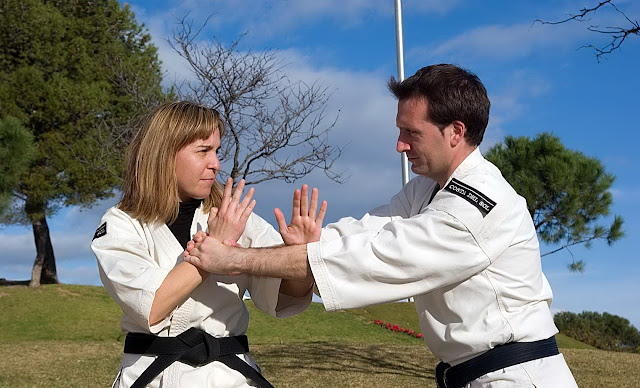Essential Self-Defense Tips for Everyday Safety
Essential
Self-Defense Tips for Everyday Safety
In
today's world, personal safety is more important than ever. Whether walking
home at night, traveling alone, or simply going about your daily routine,
knowing how to protect yourself can make all the difference. Self-defense is
not just about fighting back; it's about awareness, prevention, and confidence.
Here are some essential self-defense tips to help you stay safe in everyday
situations.
 |
"Self-defense: A man executing an elbow strike on an attacker in an urban setting." |
1. Stay Aware and Trust Your Instincts
The
first and most important aspect of self-defense is situational awareness.
Many dangerous situations can be avoided simply by being aware of your
surroundings. Here’s how:
- Avoid
distractions: Keep your phone away while
walking and stay alert.
- Trust your gut:
If something feels off, remove yourself from the situation.
- Make eye
contact: This signals confidence and
deters potential attackers.
- Know your exits:
Whether in a building or on the street, always be aware of escape routes.
2. Use Your Voice to Deter Attackers
One of
the most powerful self-defense tools you have is your voice. If you feel
threatened:
 |
| Make eye contact |
Speak up loudly: A strong "STOP!" or "BACK OFF!" can scare off an attacker.
- Call for help:
Shouting "FIRE!" instead of "HELP!" can grab more
attention.
- Make eye contact
and stand your ground: Attackers often target those who
appear weak or distracted.
3. Learn Basic Self-Defense Moves
You
don’t need to be a martial arts expert to defend yourself. Knowing a few simple
techniques can help you escape a dangerous situation:
 |
| learn basic self defence moves |
- Palm strike:
A forceful strike to the nose can temporarily disable an attacker.
- Elbow strike:
If someone is close, use your elbow to strike the chin, nose, or ribs.
- Knee to the
groin: This is one of the most effective
ways to incapacitate an attacker.
- Heel stomp:
If grabbed from behind, stomp hard on the attacker’s foot.
- Escape from a
wrist grab: Twist your arm in the direction
of their thumb and pull away.
4. Carry and Use Self-Defense Tools
Having
the right self-defense tools can provide an extra layer of protection. Some
effective options include:
- Pepper spray:
Easily carried in a pocket or purse, it can temporarily blind an attacker.
- Personal alarm:
A loud noise can attract attention and scare off an attacker.
- Tactical
flashlight: Can be used to disorient an
attacker and illuminate dark areas.
- Keychain weapons: Items like Kubotans or self-defense keychains can be effective in close encounters.
Make
sure you know how to use these tools before you need them. Practice
quick access and proper handling.
 |
| Use pepper spray in danger |
5. Stay in Well-Lit and Populated Areas
Criminals
prefer isolated and dark areas where they won’t be seen. Reduce your risk by:
- Walking in
well-lit areas and avoiding shortcuts through
alleys or empty streets.
- Sticking to main
roads rather than secluded paths.
- Walking with a
group whenever possible.
If you
must walk alone at night, carry a flashlight and hold your phone
ready to call for help.
6. Use the “Command Stance” to Show
Confidence
Your body
language plays a huge role in self-defense. A confident stance can deter
potential attackers. Follow these tips:
- Stand tall with
your feet shoulder-width apart.
- Keep your hands
up, palms facing forward, in a defensive but non-aggressive posture.
- Maintain direct
but non-confrontational eye contact.
Attackers
are less likely to target someone who looks alert and prepared.
7. Know When to Fight Back
If
avoidance is not possible and you are being attacked, fighting back might be
your only option. Key points to remember:
- Aim for weak
points: eyes, nose, throat, groin, and knees.
- Use force
effectively: Strike fast and hard, then escape.
- Don’t stop until
you can safely get away.
- Use available
objects: Bags, keys, or even a rolled-up newspaper can be used as a
weapon.
While
reading about self-defense is helpful, nothing beats hands-on training.
Consider taking a class in:
 |
| Effective blocking and counter techniques |
- Krav Maga
– A practical and efficient combat system.
- Brazilian
Jiu-Jitsu – Teaches how to escape from
grabs and holds.
- Kickboxing
– Great for developing striking power.
- Basic
self-defense courses – Often offered at community
centers, gyms, or online.
Regular
practice will help you develop muscle memory, so your reactions become automatic
in high-stress situations.
9. Have an Emergency Plan
Preparation
is key to handling emergencies effectively. Some steps to take:
- Set up emergency
contacts on your phone.
- Share your
location with a trusted friend or family
member when traveling alone.
- Know your escape
routes in common places you visit (home,
work, school).
- Keep emergency
numbers handy (local police, friends, or family
members who can help).
10. Maintain Physical Fitness for Better
Defense
Being
physically fit improves your ability to run, fight back, and endure
stressful situations. A few exercises that help:
- Cardio training
(running, jumping rope) to improve stamina.
- Strength
training (push-ups, squats) for increased
power.
- Flexibility
exercises (yoga, stretching) for better
movement and injury prevention.
 |
| A woman applying an arm lock on an attacker |
Final Thoughts
Self-defense
is about prevention, awareness, and preparation. The goal is not to
engage in fights but to avoid danger and protect you effectively. By
incorporating these self-defense strategies into your daily life, you can boost
your confidence and reduce your risk of harm.
Stay
alert, stay prepared, and stay safe! 😊



Comments
Post a Comment
"We love hearing from you! Please keep comments respectful and on-topic. 😊"